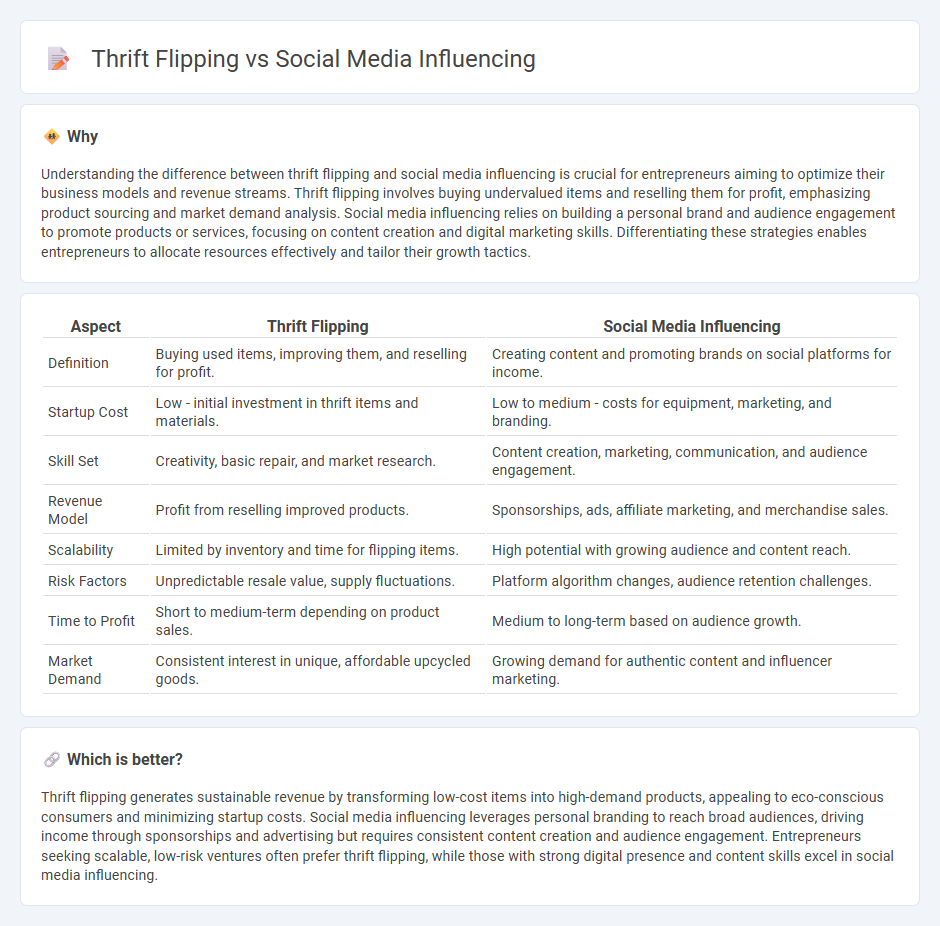
Thrift flipping involves purchasing secondhand items, creatively upcycling them, and reselling for profit, showcasing hands-on entrepreneurial skills in sustainable retail. Social media influencing leverages personal branding and digital platforms to promote products or services, generating income through partnerships and sponsored content. Explore the distinct opportunities and challenges each model presents for modern entrepreneurs.
Why it is important
Understanding the difference between thrift flipping and social media influencing is crucial for entrepreneurs aiming to optimize their business models and revenue streams. Thrift flipping involves buying undervalued items and reselling them for profit, emphasizing product sourcing and market demand analysis. Social media influencing relies on building a personal brand and audience engagement to promote products or services, focusing on content creation and digital marketing skills. Differentiating these strategies enables entrepreneurs to allocate resources effectively and tailor their growth tactics.
Comparison Table
| Aspect | Thrift Flipping | Social Media Influencing |
|---|---|---|
| Definition | Buying used items, improving them, and reselling for profit. | Creating content and promoting brands on social platforms for income. |
| Startup Cost | Low - initial investment in thrift items and materials. | Low to medium - costs for equipment, marketing, and branding. |
| Skill Set | Creativity, basic repair, and market research. | Content creation, marketing, communication, and audience engagement. |
| Revenue Model | Profit from reselling improved products. | Sponsorships, ads, affiliate marketing, and merchandise sales. |
| Scalability | Limited by inventory and time for flipping items. | High potential with growing audience and content reach. |
| Risk Factors | Unpredictable resale value, supply fluctuations. | Platform algorithm changes, audience retention challenges. |
| Time to Profit | Short to medium-term depending on product sales. | Medium to long-term based on audience growth. |
| Market Demand | Consistent interest in unique, affordable upcycled goods. | Growing demand for authentic content and influencer marketing. |
Which is better?
Thrift flipping generates sustainable revenue by transforming low-cost items into high-demand products, appealing to eco-conscious consumers and minimizing startup costs. Social media influencing leverages personal branding to reach broad audiences, driving income through sponsorships and advertising but requires consistent content creation and audience engagement. Entrepreneurs seeking scalable, low-risk ventures often prefer thrift flipping, while those with strong digital presence and content skills excel in social media influencing.
Connection
Thrift flipping leverages social media influencing to showcase creative upcycling and sustainable fashion, driving consumer engagement and boosting resale value. Platforms like Instagram and TikTok serve as dynamic marketplaces where influencers demonstrate thrift flips, inspiring audiences to adopt eco-friendly shopping habits. This synergy fosters entrepreneurial growth by combining creative craftsmanship with digital marketing strategies.
Key Terms
**Social Media Influencing:**
Social media influencing harnesses platforms like Instagram, TikTok, and YouTube to create brand awareness and engage target audiences through authentic content and personal storytelling. Influencers leverage metrics such as follower count, engagement rate, and reach to attract partnerships with brands seeking targeted marketing campaigns. Discover strategies and trends shaping the future of social media influencing in the digital age.
Personal Branding
Social media influencing leverages personal branding to build a relatable and authentic online presence, attracting targeted audiences and brand partnerships. Thrift flipping enhances personal branding by showcasing creativity and sustainability, appealing to eco-conscious followers and niche markets. Explore how combining these strategies can elevate your personal brand and expand your digital impact.
Audience Engagement
Social media influencing drives audience engagement through curated content, leveraging trends and personal branding to build trust and interaction. Thrift flipping captivates niche audiences by showcasing creative transformation of second-hand items, fostering community around sustainability and unique style. Explore deeper insights on how these strategies maximize engagement and grow loyal followings.
Source and External Links
Social media influence - (Intro to Humanities) - Fiveable - Social media influence is the ability of individuals or organizations to sway opinions, behaviors, or actions of others through platforms like Facebook, Instagram, and TikTok, shaping cultural trends and societal norms globally.
Influencers and Social Media | EBSCO Research Starters - Influencers use social media to connect communities around shared values, influencing product engagement and social justice causes while raising concerns on credibility, especially in scientific topics.
The Rise of the Social Media Influencer | Viewpoint - Social media influencers gain trust and relatability by shifting influence power from brands to customers, who now inform their networks' perceptions more than traditional marketers.
 dowidth.com
dowidth.com